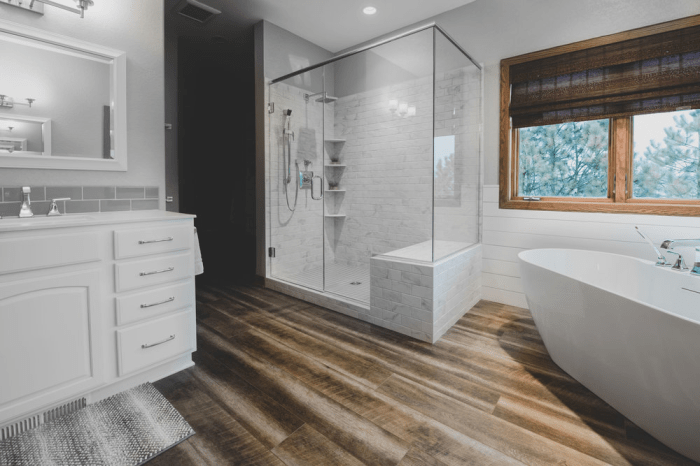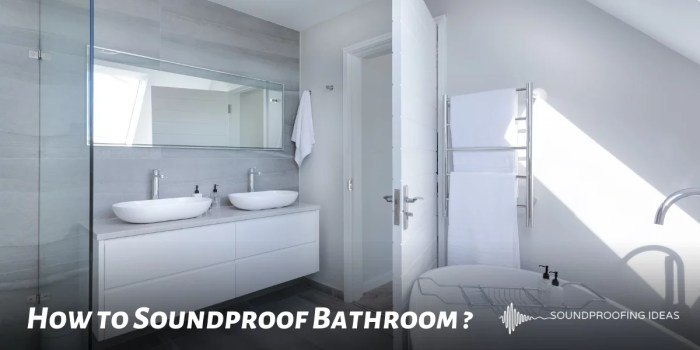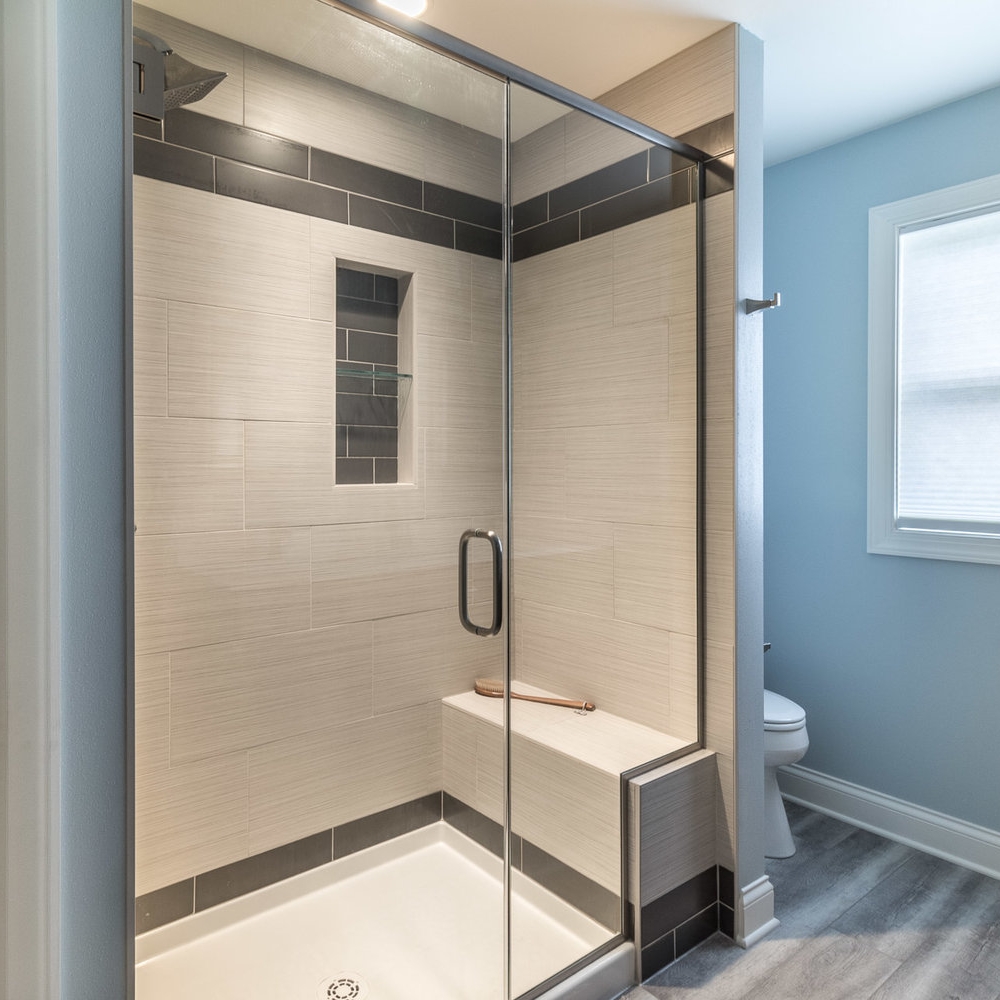In multi-level homes, maintaining a peaceful and serene environment can be a challenge, especially when it comes to noise transmission. Bathroom floors, in particular, can be a major source of unwanted sound, disrupting the tranquility of both occupants and neighbors.
This guide will delve into the intricacies of soundproofing bathroom floors in multi-level homes. We’ll explore the unique challenges, discuss effective materials and methods, and provide practical tips to enhance the overall effectiveness of your soundproofing efforts.
Introduction
Soundproofing refers to the techniques used to reduce the transmission of sound through a structure, improving acoustic comfort and privacy. In multi-level homes, soundproofing bathroom floors is crucial to minimize noise disturbance between different levels.
Bathroom floors pose unique soundproofing challenges due to the presence of plumbing fixtures, which can act as sound conduits. Additionally, the use of hard surfaces like tile and porcelain can amplify sound transmission.
Materials for Soundproofing
Selecting the right materials is essential for effective soundproofing. Consider the following options:
- Mass Loaded Vinyl (MLV): A thin, heavy material that adds mass to the floor, reducing sound transmission.
- Acoustic Underlayment: A layer of sound-absorbing material placed beneath the flooring to absorb impact noise.
- Resilient Channel System: A network of metal channels that creates a floating floor, isolating it from the subfloor and reducing vibration.
Materials for Soundproofing Bathroom Floors
Choosing the right soundproofing materials is crucial for effective sound reduction. Here’s a guide to various options and their effectiveness:
Types of Soundproofing Materials
- Mass Loaded Vinyl (MLV): A dense, flexible material that absorbs sound vibrations. Highly effective but can be expensive.
- Acoustic Underlayment: A thin layer of foam or rubber placed beneath flooring to absorb impact noise. Affordable and easy to install.
- Resilient Channels: Metal channels that isolate the subfloor from the flooring, creating a sound barrier. More expensive than underlayment but more effective.
- Soundproofing Drywall: Drywall with a special sound-dampening core. More effective than regular drywall but can be more challenging to install.
- Cork Flooring: A natural material with excellent sound absorption properties. Can be expensive but provides both sound and thermal insulation.
Comparison of Materials
| Material | Sound Reduction (STC) | Cost per Square Foot |
|---|---|---|
| Mass Loaded Vinyl | 25-30 | $1.50-$3.00 |
| Acoustic Underlayment | 10-15 | $0.50-$1.50 |
| Resilient Channels | 15-20 | $1.00-$2.50 |
| Soundproofing Drywall | 20-25 | $1.20-$2.00 |
| Cork Flooring | 15-20 | $5.00-$10.00 |
The choice of material depends on the desired level of sound reduction and budget. For significant sound reduction, consider MLV or soundproofing drywall. For budget-friendly options, acoustic underlayment or resilient channels are suitable.
Methods for Soundproofing Bathroom Floors
To effectively soundproof your bathroom floor, a combination of materials and techniques is required. Here are step-by-step methods to guide you through the process:
Floor Preparation
- Remove the existing flooring and underlayment.
- Inspect the subfloor for any damage or unevenness. Repair or level as needed.
Soundproofing Materials Installation
Acoustic Underlayment
Lay down a thick acoustic underlayment over the subfloor. This will absorb impact noise and vibrations.
Resilient Channel
Install resilient channels perpendicular to the floor joists. These channels will create a floating floor system, isolating the flooring from the subfloor.
Soundproofing Compound
Apply a soundproofing compound to the resilient channels. This will further reduce vibrations and sound transmission.
Flooring Installation
Floating Floor
Install a floating floor, such as laminate or engineered hardwood, over the soundproofing materials. Ensure there is a gap between the flooring and walls to allow for expansion and contraction.
Ceiling Baffles
For bathrooms below other living spaces, consider installing ceiling baffles in the room below. These baffles will absorb sound waves and reduce noise transmission.
Considerations for Soundproofing Bathroom Floors
To effectively soundproof a bathroom floor, it is essential to consider several key factors:
Type of Flooring: Different flooring materials possess varying sound-absorbing properties. Consider using materials like cork, rubber, or sound-absorbing underlayments to minimize impact and airborne noise.
Existing Infrastructure: The existing bathroom infrastructure, including the floor joists and subfloor, can impact the effectiveness of soundproofing measures. Assess the condition of these components and consider reinforcing or adding sound-isolating materials.
Budget: Soundproofing bathroom floors can involve varying costs depending on the materials and methods used. Determine your budget and explore cost-effective options to achieve the desired level of soundproofing.
Tips for Enhancing Soundproofing
Enhancing the effectiveness of soundproofing in bathroom floors requires meticulous attention to detail and the implementation of additional measures. Consider incorporating the following tips to further mitigate noise transmission:
Use Sound-Absorbing Curtains or Rugs
Sound-absorbing curtains or rugs can significantly reduce noise levels by absorbing sound waves before they bounce off hard surfaces. Place curtains on windows and shower doors, and place rugs on the floor to trap sound within the bathroom.
Outcome Summary
Soundproofing bathroom floors in multi-level homes requires careful planning, appropriate materials, and meticulous execution. By following the principles Artikeld in this guide, you can effectively minimize noise transmission, creating a more peaceful and enjoyable living space for yourself and your neighbors.








